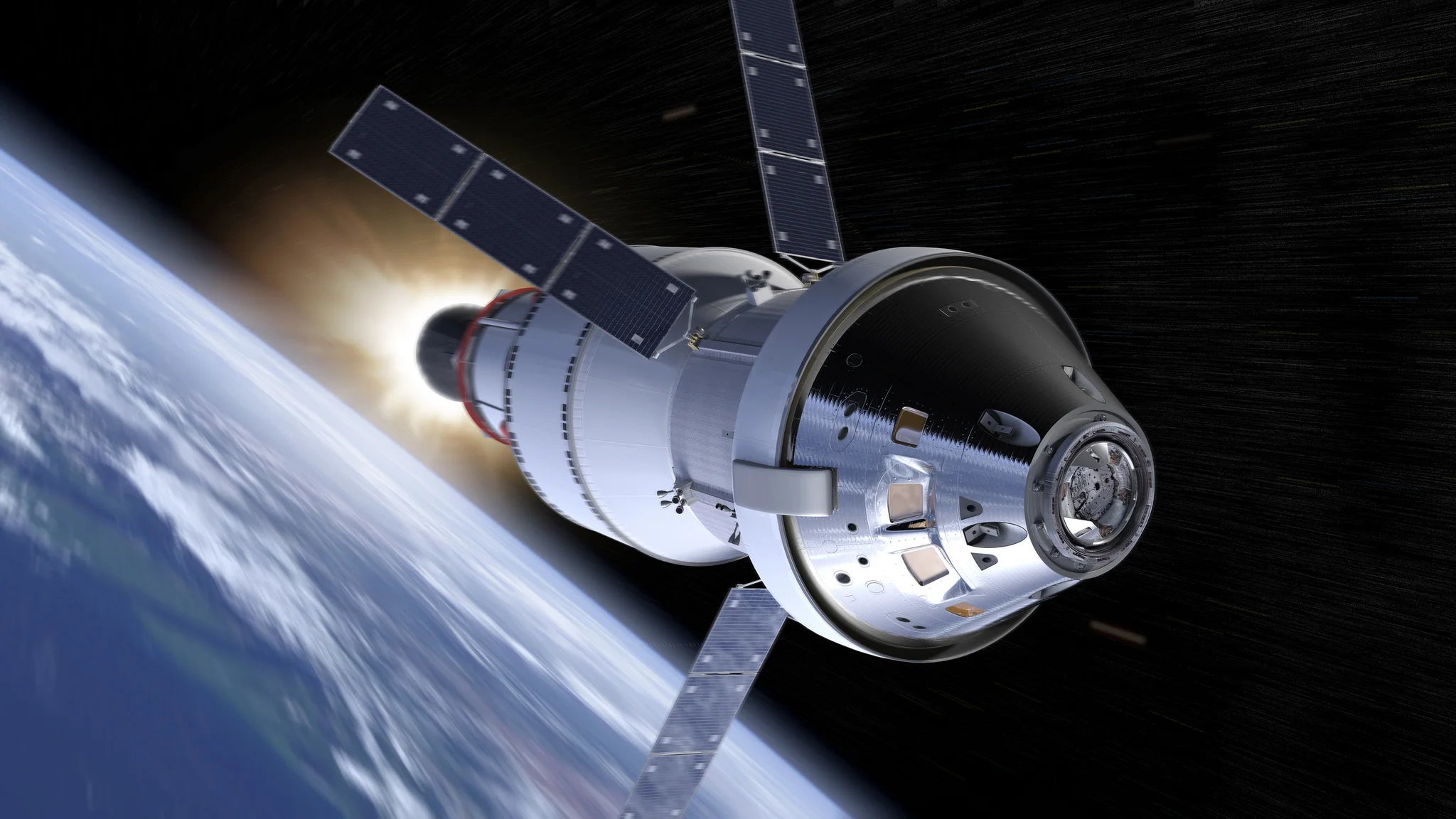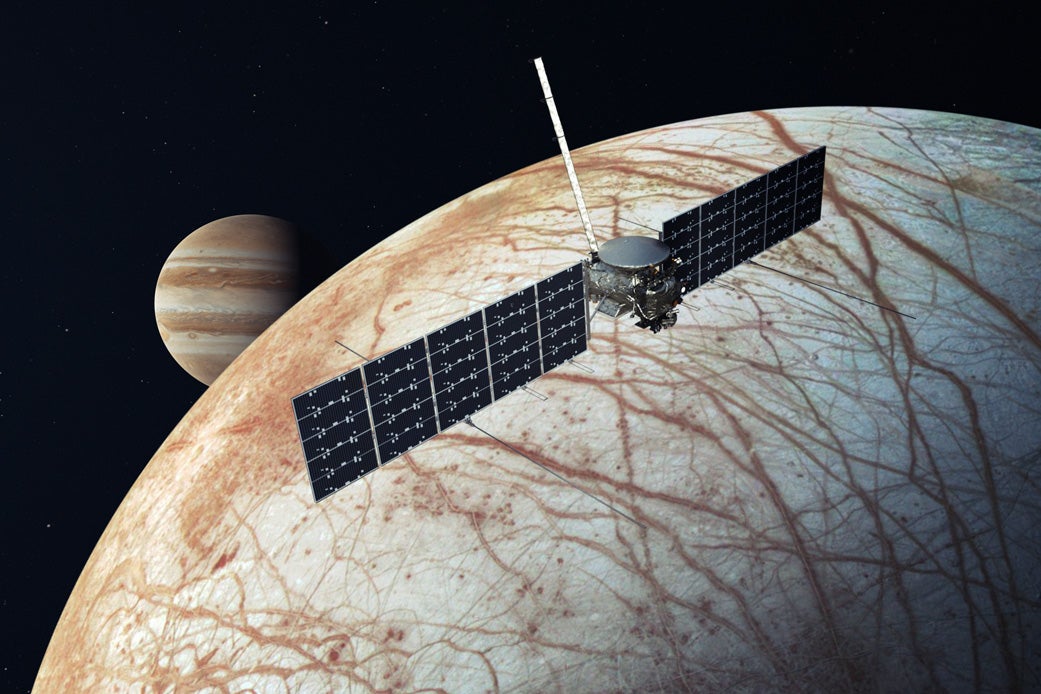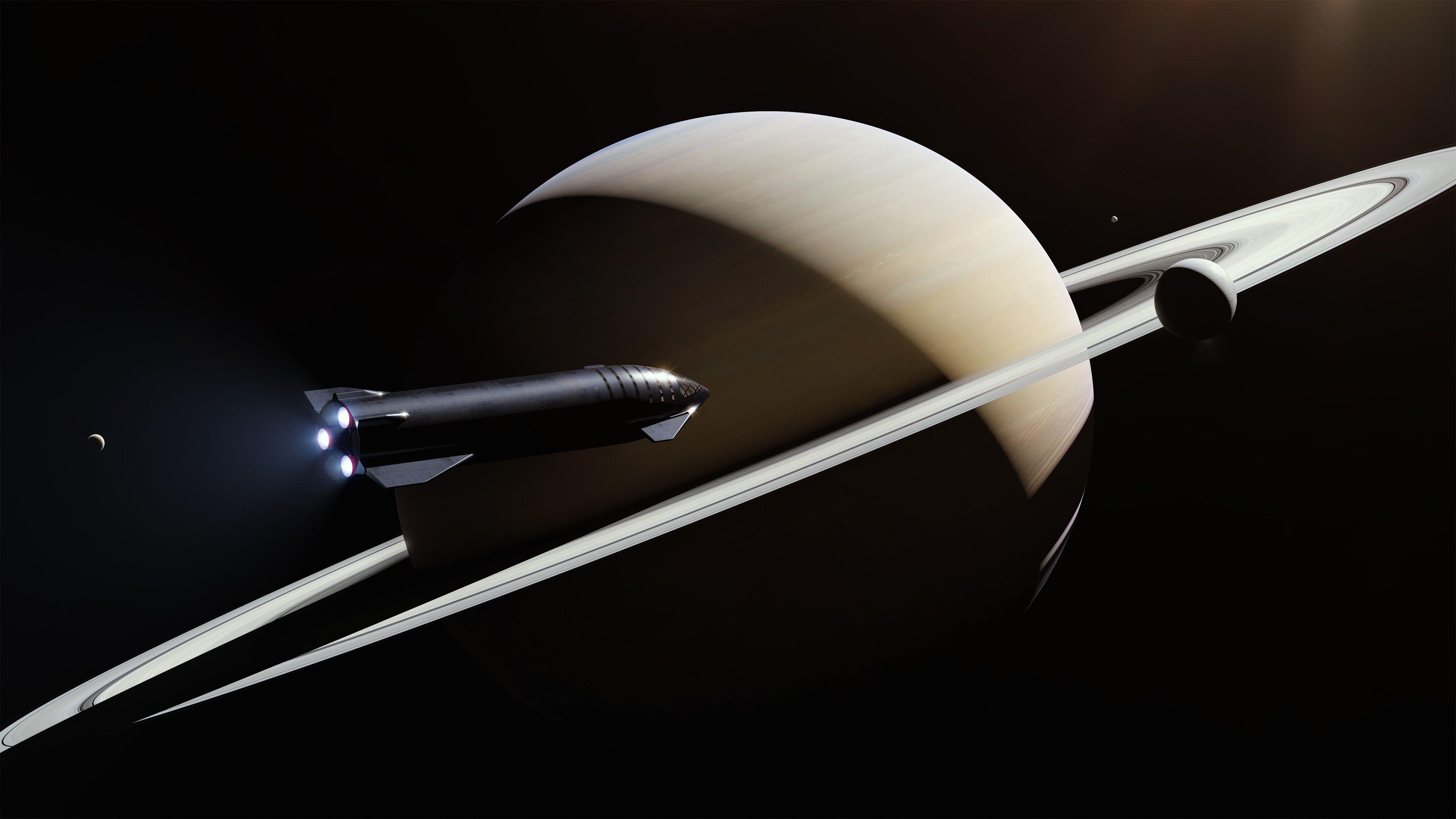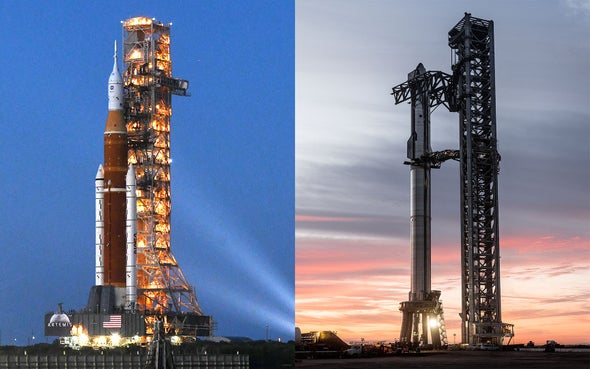Astronomers breathed a collective sigh of relief as the James Webb Space Telescope (JWST) sprung to life. Getting the $10-billion telescope up and running following its launch on Christmas Day 2021 had been a nerve-racking affair. JWST would not fit into any modern rocket without being folded, and it had to rely on hundreds of moving parts to unfurl to full size once in space. Ultimately those efforts were successful, and the telescope has started returning some of its first calibration images to thrilled audiences back on Earth. Yet the experience left many astronomers wondering if there was a simpler way to build and launch telescopes of this size. “We were worried about the unfolding,” says John Blevins of NASA’s Marshall Space Flight Center. But with a larger rocket, “you don’t have to unfold in space. You can do it on the ground.”
As chance would have it, two such rockets are currently sitting on launchpads. Each should ultimately exceed the power of the mighty Saturn V, which sent the Apollo astronauts to the moon. The first, NASA’s Space Launch System (SLS), is ready and waiting at Kennedy Space Center in Florida for its inaugural uncrewed voyage around the moon as part of the Artemis I mission—the opening shot in NASA’s plan to return humans to the lunar surface in the 2020s. The rocket, tentatively scheduled for a launch in late August, is meant to be as reliable as possible and is therefore based, in large part, on legacy hardware from NASA’s Space Shuttle program.
But a reliance on tried-and-true technology could be its Achilles’ heel: some estimates currently peg the SLS’s cost at an eye-watering $4.1 billion per launch. Presuming it is not scuttled by congressional appropriators feeling buyer’s remorse, its massive size could eventually be a boon for scientists seeking to send larger, more ambitious spacecraft and telescopes throughout the solar system—and even beyond.
Over in Texas, Starship, a similarly capable but wildly different rocket being developed by SpaceX, is also in preparation to launch on its first orbital test flight, pending regulatory approval from the Federal Aviation Administration. The cost of the SLS seems so egregious because each multibillion-dollar rocket will be discarded after a single use, its components relegated to the seafloor as junk or left adrift in space. Such was the standard for most of the space age, but times have changed. Starship and its giant Super Heavy booster are instead built for endurance, landing back on the ground for rapid reuse similar to SpaceX’s current fleet of Falcon rockets, which has already dramatically lowered the cost of reaching space. As big and bold as the SLS may be, experts say it pales in comparison with what Starship could achieve. “Starship holds the promise of transforming the solar system in a way we can’t really appreciate,” says Alan Stern of the Southwest Research Institute in Texas, who helms NASA’s New Horizons mission, which flew by the dwarf planet Pluto in 2015. “It completely changes the game.”

Either rocket’s shroudlike payload fairing is spacious enough to fit cargo as big as or even bigger than JWST, all without the need to fold components into the world’s most expensive origami. And both launchers will possess such immense thrust they can reach remote corners of the solar system on shorter time scales with larger spacecraft than smaller rockets. Starship alone, however, is designed to be refueled in space, meaning it could transport mind-bogglingly huge payloads to hard-to-reach locales such as Jupiter and Saturn—or anywhere else around the sun, for that matter.
As this hopeful new era of the super-rocket dawns, eager scientists are vying to be along for the ride. “These rockets can enable whole new classes of missions—to all the giant planets and the Kuiper belt objects, to the ocean world satellites and the dwarf planets of the solar system,” Stern says. “They’re across-the-board useful.” Now many are busy drawing up ideas for what might be possible, at the moment focusing more on the SLS because of its greater maturity but keeping a beady eye on Starship and its potentially revolutionary capabilities.
The Science Launch System?
After its initial moonshot, NASA officials say, the SLS will primarily be used to launch the agency’s Orion spacecraft with crew onboard. Those launches will work in tandem with NASA-contracted Starship launches, which will serve to land an Artemis crew on the moon as early as 2025—and perhaps one day send astronauts to the surface of Mars. “We expect approximately one human landing per year over a decade or so,” NASA’s administrator Bill Nelson said in a press conference on March 23. As a result, no SLS rocket is likely to be available to solely launch any sort of telescope or scientific probe into the solar system until the 2030s. “Given the demands of the Artemis program between now and the late 2020s, it’s going to be very difficult to squeeze a science mission in that time frame,” said Robert Stough, payload utilization manager of SLS at the NASA Marshall Space Flight Center, in a 2021 briefing.
Consequently, in 2021 NASA switched the planned 2024 launch of its Jupiter-bound flagship mission, Europa Clipper, from the SLS to a SpaceX Falcon Heavy. Even so, agency officials are bullish that the SLS’s exorbitant costs and sluggish launch rate can be improved, creating more opportunities for science missions. In his briefing, Stough estimated that $800 million or lower was an achievable target by the 2030s. According to a paper presented at a November 2020 American Institute of Aeronautics and Astronautics (AIAA) meeting, SLS’s final, most powerful planned configuration could be supercharged with the addition of a new “kick stage” that would add propulsion to the top of the rocket. Such an upgrade would allow the SLS to send some 16 metric tons to Jupiter, about six metric tons to Neptune and one metric ton to interstellar space. The New Horizons mission to Pluto, by comparison, had a mass of half a metric ton. “There’s no rocket right now that can carry anywhere near this payload,” says Blevins, who is chief engineer of the SLS at Marshall.
On April 19, 2022, the National Academies of Sciences, Engineering, and Medicine released its much awaited Planetary Science and Astrobiology Decadal Survey, which recommends NASA’s otherworldly science priorities well into the 2030s. As part of the survey, NASA solicited studies from scientists on mission concepts that the agency might consider for targets in the outer solar system. Three of those suggested using the SLS to allow faster, bulkier missions: a Pluto orbiter, an orbiter and lander to Saturn’s moon Enceladus, and an orbiter and atmospheric probe to Neptune. “We wanted to use existing or very near-term technology,” says Kirby Runyon of the Johns Hopkins University Applied Physics Laboratory (JHUAPL), who is part of the proposed Neptune mission. “The SLS is the furthest along in its design and maturation of any of the very large vehicles.”

Runyon’s group’s proposal, Neptune Odyssey, would launch as soon as 2031 on an SLS rocket to enter orbit around Neptune in the 2040s. The mission would provide unprecedented insight into a planet that has been visited only once, in a fleeting flyby from the Voyager 2 spacecraft in 1989 on its journey out of the solar system. Odyssey would study Neptune and its largest moon Triton for four years while also deploying a probe into the planet’s stormy atmosphere. Slightly smaller rockets such as the Falcon Heavy could also get Odyssey to Neptune but only via various add-ons that would raise the mission’s cost and complexity while reducing its tolerance for error. That approach “is definitely more risky,” Runyon says.
The Enceladus Orbilander, meanwhile, would be a mission to seek out signs of life within the Saturnian moon’s ocean, which is ejecting plumes of water vapor and organic molecules through cracks in its overlying icy crust. The spacecraft could fly through and sample the plumes before landing on the moon’s surface to perform in situ studies. The SLS, again, makes a mission like this easier than it would be with a smaller rocket, which would require gravitational boosts from planetary flybys in the inner solar system. “This means we don’t have to design the spacecraft to survive both the warm conditions of the inner solar system and the frigid conditions out at Saturn,” says Shannon MacKenzie, the concept’s lead at JHUAPL.
Even the SLS has its limitations, though. Assuming a launch in 2031, the giant rocket would still take nearly three decades to propel a proposed orbiter, called Persephone, to Pluto. And despite its immense size, the SLS is still limited by its inability for on-orbit refueling to boost its carrying capacity once in space. In their more audacious dreams of cosmic exploration, scientists have eyes for only one rocket: Starship. “Starship is not just an incremental change,” says Jennifer Heldmann of the NASA Ames Research Center. “This is a significant paradigm shift.”
Into the Unknown
Starship, by its design, can be refueled by other Starship vehicles in Earth orbit. This means it could, hypothetically, carry a huge amount of mass around the solar system. “You could get a 100-ton object to the surface of Europa,” SpaceX’s CEO Elon Musk said in a public meeting of the National Academies in November 2021. That is a five times greater performance than the very best the SLS can offer, even in its final configuration with a kick stage. Starship is also forecast to be significantly cheaper, although whether it can hit Musk’s optimistic projection of less than $10 million per launch remains to be seen. “If they get anywhere near that cost, it’s kind of an analogue to a 747 and a shipping container all in one,” says Robin Hague, former head of launch at the U.K. launch company Skyrora. “That’s going to be used throughout the solar system.”

With 1,000 cubic meters of usable volume, Starship is also big enough to fit the entire Eiffel Tower, disassembled (though not powerful enough to lift it into orbit). This gargantuan capability led Heldmann and her colleagues to publish a paper on what sort of equipment Starship could carry to the lunar or Martian surface. “Refilling Starship in orbit effectively resets the rocket equation, allowing for large payloads to be transported to the Moon and Mars,” they wrote, a reference to the fact that the more mass you want to launch, traditionally, the more thrust you need on an exponential scale. Starship is not limited to these destinations, though. “It is not fine-tuned to either the moon or Mars,” says Margarita Marinova, a former senior Mars development engineer at SpaceX. “The goal for Starship is to create this more generic, larger-scale exploration capability.”
Ideas include launching full-size drills rather than pint-size versions. “You can put a 100-foot [30-meter] drill on the vehicle and then just deploy it,” Heldmann says. “You don’t have to try and fold it up. That’s exciting because you can drill down into ice on Mars, which is very important for sustaining human exploration and also the search for life.” Starship could conceivably also offer a two-way delivery service, returning vast quantities of material to Earth from these and other worlds. “We’ve always been very cautious about the samples we return because we’ve been limited by the amount of mass,” Heldmann says. “With Starship, you can just load up that vehicle with rocks and ice and whatever else you find.”
Meanwhile Martin Elvis of the Harvard-Smithsonian Center for Astrophysics and his colleagues have written a white paper on how Starship’s unique capabilities could be used to launch a wide variety of next-generation space telescopes to revolutionize astrophysics. One idea is an extension of the Event Horizon Telescope, a “virtual” observatory on Earth used in 2019 to capture the first-ever image of a supermassive black hole. In a single launch, Starship could send a stack of six-meter telescopes into space, allowing for the creation of a much larger virtual telescope. That could provide views of “thousands of supermassive black holes” found at the centers of galaxies like our own, Elvis says.
Starship—and the SLS—could also launch a large telescope custom-built to image Earth-like exoplanets around other stars, as recommended to NASA by the National Academies’ Astronomy and Astrophysics Decadal Survey in November 2021. “The diameter of mirror the Decadal report suggested was six meters, which is about the same as the JWST,” Elvis says. But with a super-rocket’s large payload fairing, such a mirror could be monolithic, without any need to unfold and deploy in space, probably resulting in major cost savings and a speedier path to the launchpad. “That would simplify the design dramatically,” Elvis says.
A Cavalcade of Rockets
The SLS and Starship are not the only options for future heavy exploration of the solar system. The Washington State–based company Blue Origin, founded by Jeff Bezos, is working on a reusable rocket called New Glenn that it says could loft 45 metric tons into Earth orbit. And New Glenn’s successor New Armstrong is expected to be even more powerful. Both Blue Origin rockets could play a role in the scientific exploration of the solar system, although their true capabilities are unknown. China, meanwhile, is working on its own superheavy rocket called the Long March 9 to transport humans and machinery to the moon and Mars as early as the 2030s. It is touted as being able to lift as much as 140 metric tons to Earth orbit, says Andrew Jones, a space journalist who closely follows the Chinese space program.
“They’re set on a super-rocket,” Jones says. “We’re seeing China become more and more interested in planetary exploration—and even looking beyond the boundaries of the solar system.” That latter notion is also something the U.S. is considering with a proposed mission called Interstellar Probe, which may need to rely on the SLS or a similarly sized rocket to reach its full scientific potential. “Without SLS or larger launch vehicles, you could not do the Interstellar Probe as intended,” says Runyon, who is planetary science lead for the proposal.
.jpg)
Some have wondered if this new generation of superheavy-lift vehicles is needed at all and whether multiple smaller launchers could send spacecraft components into orbit for subsequent assembly by astronauts or robots. That same modular approach could also be used to launch rocket fuel to fill orbital depots, potentially offering similar enhancements to in-space capabilities without the need for a giant rocket. This fuel-depot idea is rumored to have been much maligned by NASA in the early days of the SLS’s development because it undercut the rationale for the program in the first place. George Sowers, former chief scientist at the United Launch Alliance (ULA) and now at the Colorado School of Mines, says he had worked on such ideas at ULA a decade ago but was asked to stop. “It got really political,” he says. “We were basically told to sit down and shut up.” NASA would later change its tune, and the agency has since selected ULA and others to demonstrate in-space refueling and depot technology.
Daniel Dumbacher, now executive director of AIAA and formerly part of the leadership at NASA that selected the SLS for development in 2010, says other options were considered. The agency looked at a variant of the SLS that used kerosene rather than the liquid hydrogen and oxygen version that was opted for in the end. That system also used smaller rockets launched in tandem like ULA’s Atlas V or SpaceX’s Falcon Heavy. But ultimately, such an option was deemed too complex and expensive. “We did look at an option of what it would take if we utilized Atlas V– and Falcon Heavy–class vehicles,” Dumbacher says. “It was down-selected out because it had negative effects on mission reliability and was more costly because of the number of launches required to execute the mission.” More than 10 launches would have been needed to replicate a single SLS launch, he says.
There is no denying that the SLS is an expensive machine. Yet given its technological maturity, if costs can be brought down, it remains a promising choice for future scientific missions. Starship, meanwhile, represents something entirely new in space exploration. There is much that has yet to be proved, including the launch and landing of the giant rocket and its ability to refuel in space. But if those hurdles can be overcome, exploration of the solar system and the cosmos may be limited not primarily by rockets but rather by human imagination.
“There’s a ton of excitement about what really high-performance rockets will enable,” Runyon says. “The solar system really opens up in a way that’s never been done before.”


